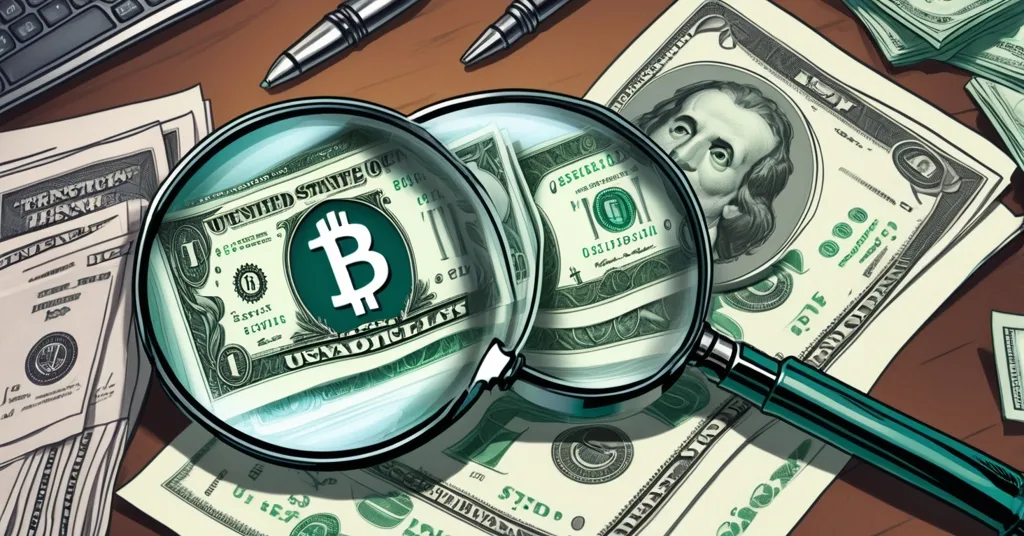Tether CEO Claims USDT Bolsters U.S. Dollar Dominance Amid Transparency Efforts

Tether CEO Declares USDT a Pillar of U.S. Dollar Dominance
In a bold statement that shook the financial world, Tether CEO Paolo Ardoino declared USDT as a crucial pillar in the ongoing saga of U.S. dollar hegemony. Speaking to CNBC, Ardoino didn’t mince words about Tether’s significant financial clout, likening the company’s U.S. Treasury holdings to those of major nations.
- Tether’s CEO likens company to a financial superpower
- USDT’s $152 billion market cap reflects global trust
- Transparency efforts continue amidst regulatory challenges
Tether’s Financial Clout
Ardoino proudly noted that Tether holds more U.S. Treasuries than countries like Germany, Spain, and Australia. He went as far as to say that if Tether were a nation, it would rank as the 19th largest holder of U.S. Treasuries. While we’re not about to start issuing Tether passports, this comparison certainly puts into perspective the scale of Tether’s operations. U.S. Treasuries, or government debt securities issued by the U.S. Department of the Treasury, represent a significant portion of Tether’s reserve strategy, which also includes investments in gold to navigate the volatility of the cryptocurrency market.
With a market capitalization of $152 billion, USDT stands as the world’s most widely adopted stablecoin. A stablecoin is a type of cryptocurrency designed to minimize price volatility, often pegged to a fiat currency like the U.S. dollar. This massive market cap is a testament to USDT’s utility and trust within the crypto ecosystem. However, it’s not all sunshine and rainbows. Tether has faced its fair share of scrutiny, particularly around transparency.
Transparency Efforts
Ardoino is quick to point out Tether’s efforts to maintain openness, with regular quarterly attestations conducted by BDO, the fifth-largest auditing firm. Moreover, Ardoino expressed a commitment to securing a “Big Four” auditor—think PwC, Deloitte, EY, or KPMG—despite the regulatory hurdles and uncertainties looming over the crypto space. The “Big Four” refers to the four largest international accounting and professional services firms, and their involvement would significantly enhance Tether’s credibility.
Recent reports indicate that Tether is actively in talks with a Big Four firm, suggesting progress in this area. Furthermore, the appointment of Simon McWilliams as CFO to lead towards a full financial audit underscores Tether’s dedication to transparency. Yet, the journey is complicated by the crypto industry’s regulatory environment, including the STABLE Act and GENIUS Act, which could impact Tether’s operations and reserve management strategies.
Regulatory Challenges
The specter of “Operation Chokepoint 2.0” looms large over Tether and the entire crypto industry. This government initiative, aimed at curbing certain financial services, could tighten the regulatory screws on Tether’s operations. Ardoino’s ambition to lead in transparency and stability faces these headwinds, making Tether’s journey anything but smooth sailing.
However, President Trump’s executive order to establish a strategic cryptocurrency reserve and his promise to overhaul digital asset regulations reflect a supportive stance towards cryptocurrencies. This could influence Tether’s ability to engage with top-tier auditors and enhance its transparency efforts. The connection between Tether’s CEO and Trump’s administration, such as through Howard Lutnick, former CEO of Cantor Fitzgerald and current commerce secretary, adds an intriguing layer to Tether’s strategic positioning.
The Broader Impact
While Tether’s CEO champions USDT as a pillar of U.S. dollar dominance, critics argue that this reliance on a single stablecoin could pose systemic risks to the crypto market. The concentration of power in Tether’s hands raises questions about the future stability of the entire ecosystem. Yet, there’s no denying the impact of USDT on the world of crypto, with its $152 billion market cap reflecting global trust and adoption.
Tether’s traditional investments, particularly in U.S. Treasuries and gold, have played a crucial role in offsetting the volatility in the crypto markets. This conservative reserve management strategy has helped Tether maintain stability and generate over $1 billion in operating profit from traditional investments in Q1 2025.
Key Questions and Takeaways
What is Tether’s role in U.S. dollar hegemony?
Tether, through its USDT stablecoin, plays a significant role in spreading U.S. dollar hegemony by increasing dollar-based liquidity globally. CEO Paolo Ardoino describes Tether as a “stronghold” for U.S. dollar dominance.
How does Tether’s U.S. Treasury holdings compare to other nations?
Tether holds more U.S. Treasuries than countries like Germany, Spain, and Australia. If it were a nation, Tether would rank as the 19th largest holder of U.S. Treasuries.
What is the current market capitalization of USDT?
USDT’s market capitalization is $152 billion, making it the most widely adopted stablecoin in the world.
What steps is Tether taking to address transparency concerns?
Tether conducts regular quarterly attestations by BDO, the fifth-largest auditing firm. Additionally, Tether aims to secure a “Big Four” auditor to enhance transparency, despite regulatory challenges.
What challenges does Tether face in engaging top-tier auditors?
Top-tier auditors like PwC, Deloitte, EY, and KPMG remain cautious due to regulatory uncertainties and the evolving crypto landscape, described by Ardoino as the effects of “Operation Chokepoint 2.0.”
What is Tether’s broader strategic goal in the digital asset ecosystem?
Tether seeks to lead in transparency, stability, and monetary influence within the digital asset ecosystem, reinforcing U.S. dollar dominance and navigating regulatory and institutional barriers.
What are the potential risks of relying on Tether for U.S. dollar dominance?
Critics argue that over-reliance on a single stablecoin like USDT could pose systemic risks to the entire crypto market, potentially leading to instability if Tether faces significant issues.
“We are spreading the U.S. dollar hegemony. I think we are the stronghold.” – Paolo Ardoino
“If we were a nation, we would be the 19th largest holder of U.S. Treasuries.” – Paolo Ardoino
As we watch this story unfold, it’s clear that Tether’s journey is far from over. With its eyes set on greater transparency and a leading role in the digital asset world, Tether continues to be a key player in the global financial landscape. And while some may question their methods, there’s no denying the impact of USDT on the world of crypto. Tether’s CEO might not be handing out passports just yet, but he’s certainly making a case for Tether to be considered a financial superpower.



